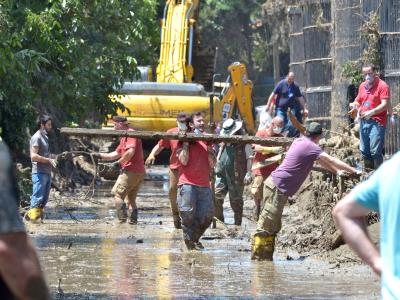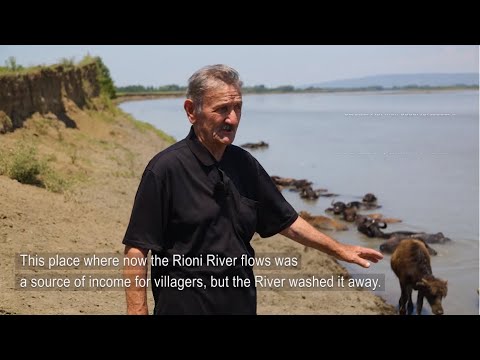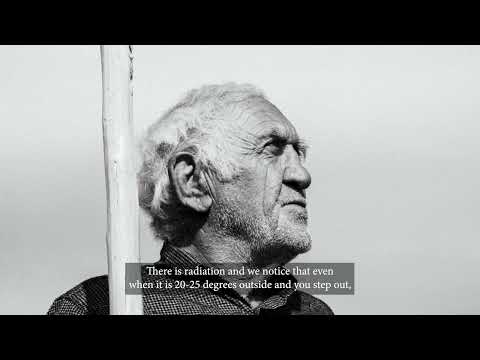
Photo:
The “Scaling-up multi-hazard early warning system and the use of climate information in Georgia” project will reduce exposure of Georgia’s communities, livelihoods and infrastructure to climate-induced natural hazards through a well-functioning nation-wide multi-hazard early warning system and risk-informed local action. The multi-hazard early warning system is an essential element of the country’s climate risk management framework and will serve 1.7 million Georgians currently at risk from climate-induced hazards.
The project will achieve this by nation-wide scaling-up of several projects and initiatives such as of the Rioni Basin flood forecasting and early warning system (FFEWS). The scaling up will be attained by developing and implementing a nation-wide Multi-Hazard Early Warning System (MHEWS), developing and delivering climate information services, and implementing community-based risk reduction measures.
Georgia’s Intended Nationally Determined Contribution (INDC) estimates economic losses from climate-induced hazards without adaptation measures for the period 2021-2030 to be US$10-12 billion, while the cost of adaptation measures is estimated to be US$1.5-2 billion. To date, hydrometeorological hazard risk management in Georgia has relied on the limited and expensive hard structural protection measures; emergency response with limited reliance on forecasts and early warning of the population; and post event compensation and relocation of victims. This reactive approach to risk reduction has resulted in eco-migrants; and high costs for post-event recovery and risk reduction. In order to adapt to climate change, Georgia is working to adopt a proactive integrated climate risk management (CRM) approach centered around risk reduction, prevention, and preparedness through the establishment of a multi-hazard early warning system and an enhanced use of climate information in planning and decision-making across all sectors.
The project will achieve transformative change in climate risk reduction and management in Georgia by development of a fully-integrated impact-based MHEWS system. In doing so it will introduce a standardized hazard, risk and vulnerability assessment and mapping methods and technologies, and provide critical climate risk information to enable the implementation of nation-wide risk reduction policies. Importantly, it will develop long-term institutional and community capacities in climate risk reduction (CRR), climate change adaptation (CCA) and MHEWS. The project will thus catalyze a paradigm shift towards climate risk-informed and resilient development and will directly benefit up to 1.7 million people (40% of the population) currently at risk from hydrometeorological hazards.
- National
- Local Governments
- National Governments
1.7 million people
- Ministry of Environment Protection and Agriculture of Georgia
- Green Climate Fund
- United Nations Development Programme (UNDP)
- Swiss Development Cooperation (SDC)
Expected outcomes
Output 1: Expanded hydro-meteorological observation network and modelling capacities secure reliable information on climate-induced hazards, vulnerability and risks
Output 2: Multi-hazard early warning system and new climate information products supported with effective national regulations, coordination mechanism and institutional capacities
Output 3: Improved community resilience through the implementation of the MHEWS and priority risk reduction measures
The GCF-financed project will scale-up pilot activities and achievements of the UNDP project Developing Climate Resilient Flood and Flash Flood Management Practices to Protect Vulnerable Communities of Georgia (Rioni project) financed by the Adaptation Fund (2012-2017) as well as another UNDP project Strengthening National Disaster Risk Reduction System in Georgia. In addition, the GCF project will implement recommendations arising from the 2015 Tbilisi Disaster Needs Assessment Report prepared by the World Bank, UNDP and USAID experts, and 2015 Tbilisi Disaster Recovery Vulnerability Reduction Plan.
There is no nation-wide hazard forecasting early warning system in the country. The most complete and integrated almost real-time EWS for flood/flashfloods was recently developed and operationalized for the Rioni River Basin, developed under the UNDP project financed by the Adaptation Fund (Rioni project). For other basins, as well as for other climate-induced natural hazards, there are no such completed and integrated system.
The GCF project will scale up the prototypes piloted by the Rioni project (including the hazard mapping, floodplain modelling, floodplain zoning and EWS) to include the other river basins and regions of Georgia and to encompass a broader range of key climate-induced hazards.
Several commercial sectors have been approached to gauge their willingness to pay for climate services including Hydropower sector, infrastructure investment and development sector and insurance sector. While these sectors will benefit from the climate information services and will continue to pay for such services, together they will not provide the weight of financing needed to match the present value benefits.
The project will significantly improve NEA’s capacities to meet World Meteorological Organization (WMO) standards. At present, NEA does not meet WMO standards in a number of categories.
Climate change challenges in Georgia
Due to the complex mountainous terrain and climate, Georgia is subject to both geological and hydro-meteorological hazards. According to Georgia’s 2nd and 3rd National Communications and other studies, under climate change the frequency, intensity and geographical spread of extreme hydrometeorological hazards will increase.
Georgia is subject to both geological and hydro-meteorological natural hazards including landslides, mudflows, erosion, avalanches, floods and flash floods, drought, and strong winds. There is evidence that frequency of these climate-induced disasters and associated damages have been increasing over the past decades. Climate change studies have indicated that these hazards will further increase in frequency, intensity and geographical spread over time and will have significant negative impacts on various sectors, including agriculture, health, critical infrastructure, tourism and protection of culture heritage, environment, natural resources and ecosystems.
Georgia’s Second and Third National Communications to UNFCCC as well as other studies provide evidence that further escalation of geological and hydrological processes is expected until 2050. The climate change scenarios indicate more extremes as prolonged rainfall events, concentrated in a short period of time with the potential to generate more runoff during these short periods, thereby increasing the potential for flash flooding (due to high peak river flows), mudflows and landslides. The trend of increasing average temperature for all seasons, decreasing precipitation and longer duration of dry periods, which will persist until 2050 in already dry areas will further increase the risk of droughts.
Over the last 21-year period total damages from hydrometeorological hazards were GEL 2.8 billion (US$1.2 billion) at a cost of 152 lives (22 of which occurred in the Tbilisi flash flood of 2015). Floods, landslides and mudflows make up 60% of these damages/losses and 67% of loss of life. National disaster statistics indicates that there is growing trend in cumulative damages and losses of lives from floods, droughts, avalanches, wind storms and hails over the last 20 years. The damages from single extreme events range from over 300 million GEL (US$121 million), which was attributed to 2000 extreme drought, to 700 Million GEL (US$283 million), attributed to the 1987 flood. In addition, natural hazards have resulted in internally displaced eco-migrants from economically disadvantaged areas.
Economic assessment of the impact of hydrometeorological hazards under climate change conditions shows that 1.7 million people (40% of the population) including the most vulnerable communities in remote rural and densely populated urban areas are at risk from the main hazards. Annual average damages (AAD) to properties from floods are estimated at 116.3 Million GEL (US$51.2 million) without climate change and at 282.7 Million GEL (US$124.4 Million) with climate change. The risk to agricultural land from all hazards is between 251,225 ha and 325,020 ha under baseline and climate change conditions respectively. Annual damages to agriculture from flooding alone would be 126.3 Million GEL (US$55.6 million) and 154.2 Million GEL (US$67.8 million) under baseline and climate change conditions respectively.

Suggested expanded hydrometeorological network
Channelling a safer future by UNDP Climate on Exposure
Young climate activists lead the way in climate action - June 2022
Building resilience to climate hazards -October 2022
32 Students from 8 Georgian Universities Receive “Green Scholarships” - December 2022
Output 1: Expanded hydro-meteorological observation network and modelling capacities secure reliable information on climate-induced hazards, vulnerability and risks
Activity 1.1: Expansion of the hydrometeorological network
Activity 1.2: Risk zoning based on hazard and risk maps for all (11) major basins in Georgia and hazard and risk maps for key climate-induced hazards (floods, landslides, mudflows, avalanches, hailstorms and droughts).
Activity 1.3: Introduction and implementation of methods and tools for the systematic gender-sensitive socio-economic vulnerability assessment for decision making and prioritisation of resilience investments.
Activity 1.4: A centralized multi-hazard risk information and knowledge system
Output 2: Multi-hazard early warning system and new climate information products supported with effective national regulations, coordination mechanism and institutional capacities
Activity 2.1: Institutional and legal frameworks and institutional capacity building for the MHEWS and for the enhanced use of climate information. Improved coordination and communication protocols for early warning
Activity 2.2: Development and implementation of the MHEWS covering all Georgia, building on the Rioni basin prototype and on the expanded hydrometric network to be achieved through activity 1.2
Activity 2.3: Enhancing access and the use of weather and climate information and agrometeorological information services by farmers and agricultural enterprises
Activity 2.4: MHRM planning platforms: development of basin-level multi-hazard risk management plans; municipal-level climate-informed multi-hazard response and preparedness plans
Output 3: Improved community resilience through the implementation of the MHEWS and priority risk reduction measures
Activity 3.1: Implementation of community-based early warning schemes and community-based climate risk management
Activity 3.2: Public awareness and capacity building programme at all levels to effectively deliver climate risk information and training to communities and local first-responders
- UNDPNatalia OlofinskayaRegional Technical Specialist





